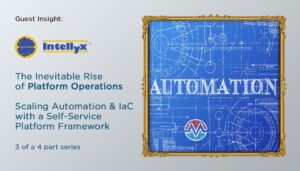BrainBlog for Morpheus Data by Jason Bloomberg
IT infrastructure automation has a turbulent history.
First, there were runbooks: simple, step-by-step instructions for how to handle certain IT processes for on-premises physical equipment. Early runbooks consisted entirely of manual steps, but over time, engineers would automate individual tasks within each runbook using configuration management tools.
Virtualization and then cloud computing brought powerful abstractions to bear. Provisioning an instance in the cloud, for example, was a simple matter of entering a few configuration parameters and clicking a few buttons – a far cry from the weeks-long process of provisioning physical servers back in the day.
More recently, cloud-based simplicity has empowered engineers to up their automation game with infrastructure as code (IaC). IaC technologies like Terraform by HashiCorp let engineers create complex, dynamic IT infrastructure automation scenarios – not simply for operations, but across the entire software development lifecycle.
However, IaC is not a panacea, as IT environments consist of hybrid, cloud-native combinations which are too dynamic and diverse for IaC to provide adequate automation.
Furthermore, every organization that is implementing such dynamic and diverse environments also struggles with staffing. There are simply not enough qualified technical people to go around.
As a result, today’s platform operations teams with limited resources need help with context and collaboration across multiple tools and clouds to support enterprise scale.
A Blueprint for Infrastructure as Code and Automation Success
IaC and configuration management in general have been important enablers of DevOps, as they bring automation to DevOps toolchains, enabling continuous deployment within CI/CD pipelines.
In practice, however, the more complex scripts become, the more they struggle with the same issues that code faces: versioning, testing, and increased complexity that limits scalability. These limitations are particularly pronounced in heterogeneous cloud native and multi-cloud environments.
At scale, pure script-based solutions with tools like IBM’s Red Hat Ansible or Terraform can become brittle. The solution is to add a layer of abstraction that enables the right tool for the right job without adding complexity.
Read the entire BrainBlog here.



